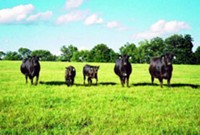Advertisement
Grab your lab coat. Let's get started
Welcome!
Welcome!
Create an account below to get 6 C&EN articles per month, receive newsletters and more - all free.
It seems this is your first time logging in online. Please enter the following information to continue.
As an ACS member you automatically get access to this site. All we need is few more details to create your reading experience.
Not you? Sign in with a different account.
Not you? Sign in with a different account.
ERROR 1
ERROR 1
ERROR 2
ERROR 2
ERROR 2
ERROR 2
ERROR 2
Password and Confirm password must match.
If you have an ACS member number, please enter it here so we can link this account to your membership. (optional)
ERROR 2
ACS values your privacy. By submitting your information, you are gaining access to C&EN and subscribing to our weekly newsletter. We use the information you provide to make your reading experience better, and we will never sell your data to third party members.
Environment
More Mad Cow Testing
Food Safety: USDA unveils plan to test more than 200,000 cattle
by Bette Hileman
March 22, 2004
| A version of this story appeared in
Volume 82, Issue 12
In a change from previous positions, the Department of Agriculture has unveiled plans to test between 201,000 and 268,000 cattle for mad cow disease within a 12- to 18-month period. The tests will be conducted at a network of state and university laboratories across the country.
In 2003, USDA tested 20,000 cattle for mad cow disease, technically known as bovine spongiform encephalopathy (BSE).
But under intense pressure from a USDA-appointed international panel and from importers of U.S. beef, USDA has decided to expand the surveillance program to get a better idea of BSE prevalence in U.S. cattle.
The new program will have the statistical power to find a BSE-infected cow even if the incidence is as low as one in 10 million, says USDA Chief Veterinary Officer W. Ron DeHaven.
So far, USDA's National Veterinary Services Laboratories (NVSL) in Ames, Iowa, have been doing all BSE testing with only one type of assay--immunohistochemistry--that requires five days for results. In the expanded testing program, rapid assays that produce results in a few hours will be used. "NVSL will conduct confirmatory tests on any animals found to be suspect in any of the rapid screening tests," DeHaven says.
Most of the cattle brains to be sampled will be from downer animals--those that cannot walk. But about 20,000 apparently healthy older cattle will also be tested. Before the surveillance program starts in June, USDA will license laboratories and specific rapid test kits.
Despite expanded surveillance, Japan has not decided to lift its ban on imports of U.S. beef. It is still demanding that the U.S. test all cattle intended for export.




Join the conversation
Contact the reporter
Submit a Letter to the Editor for publication
Engage with us on Twitter